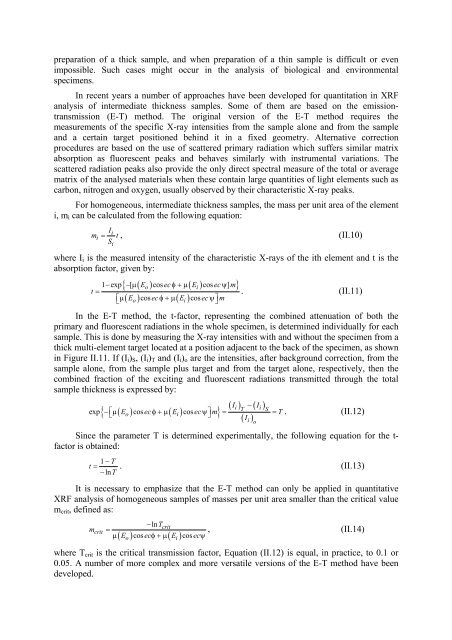X-Ray Fluorescence Analytical Techniques - CNSTN : Centre ...
X-Ray Fluorescence Analytical Techniques - CNSTN : Centre ...
X-Ray Fluorescence Analytical Techniques - CNSTN : Centre ...
You also want an ePaper? Increase the reach of your titles
YUMPU automatically turns print PDFs into web optimized ePapers that Google loves.
preparation of a thick sample, and when preparation of a thin sample is difficult or even<br />
impossible. Such cases might occur in the analysis of biological and environmental<br />
specimens.<br />
In recent years a number of approaches have been developed for quantitation in XRF<br />
analysis of intermediate thickness samples. Some of them are based on the emissiontransmission<br />
(E-T) method. The original version of the E-T method requires the<br />
measurements of the specific X-ray intensities from the sample alone and from the sample<br />
and a certain target positioned behind it in a fixed geometry. Alternative correction<br />
procedures are based on the use of scattered primary radiation which suffers similar matrix<br />
absorption as fluorescent peaks and behaves similarly with instrumental variations. The<br />
scattered radiation peaks also provide the only direct spectral measure of the total or average<br />
matrix of the analysed materials when these contain large quantities of light elements such as<br />
carbon, nitrogen and oxygen, usually observed by their characteristic X-ray peaks.<br />
For homogeneous, intermediate thickness samples, the mass per unit area of the element<br />
i, mi can be calculated from the following equation:<br />
Ii<br />
mit Si<br />
= , (II.10)<br />
where Ii is the measured intensity of the characteristic X-rays of the ith element and t is the<br />
absorption factor, given by:<br />
1−exp { − [ µ ( Eo) cosecφ+µ ( Ei) cos ecψ] m}<br />
t =<br />
. (II.11)<br />
⎡µ ( E ) cos ecφ+µ ( E ) cos ecψ⎤m ⎣ o i ⎦<br />
In the E-T method, the t-factor, representing the combined attenuation of both the<br />
primary and fluorescent radiations in the whole specimen, is determined individually for each<br />
sample. This is done by measuring the X-ray intensities with and without the specimen from a<br />
thick multi-element target located at a position adjacent to the back of the specimen, as shown<br />
in Figure II.11. If (Ii)S, (Ii)T and (Ii)o are the intensities, after background correction, from the<br />
sample alone, from the sample plus target and from the target alone, respectively, then the<br />
combined fraction of the exciting and fluorescent radiations transmitted through the total<br />
sample thickness is expressed by:<br />
( Ii) − ( I<br />
T i)<br />
S<br />
exp{ − ⎡<br />
⎣µ ( Eo) cos ecφ+µ ( Ei) cos ecψ ⎤<br />
⎦ m} = = T.<br />
(II.12)<br />
( I )<br />
Since the parameter T is determined experimentally, the following equation for the tfactor<br />
is obtained:<br />
1 − T<br />
t =<br />
−lnT<br />
. (II.13)<br />
It is necessary to emphasize that the E-T method can only be applied in quantitative<br />
XRF analysis of homogeneous samples of masses per unit area smaller than the critical value<br />
mcrit, defined as:<br />
−lnTcrit<br />
mcrit<br />
= , (II.14)<br />
µ ( Eo) cos ecφ+µ ( Ei) cos ecψ<br />
where Tcrit is the critical transmission factor, Equation (II.12) is equal, in practice, to 0.1 or<br />
0.05. A number of more complex and more versatile versions of the E-T method have been<br />
developed.<br />
i o


